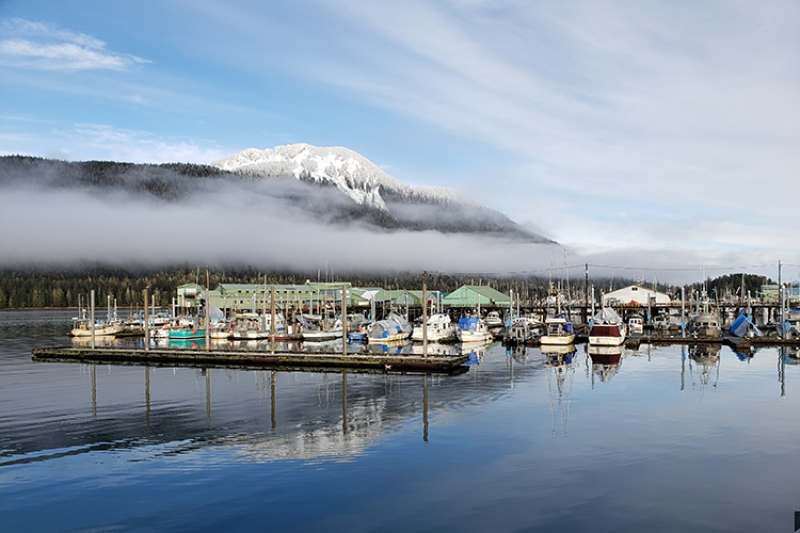In 2019, commercial fisheries off Alaska produced 5.7 billion pounds of seafood worth $2.0 billion—more than the rest of the United States. It’s the largest private sector employer in Alaska, and employs more than over 31,000 fishermen. Commercial fishing provides critical employment opportunities for isolated coastal communities throughout the state. It also provides food security, cultural transmission, and social connectivity.
Gulf of Alaska communities and boroughs, which are highly dependent on fishing to support their local economies. However, social scientists found that 16 of these communities were relatively unprepared to tackle climate change. In general, local planning that included climate adaptation measures to support fishing and support businesses was very limited.
“We found that several communities had identified some mitigation measures to reduce localized greenhouse gasses or address risks related to climate-driven stressors—floods, drought, coastal erosion, avalanches, and landslides. Yet, only five community plans directly address climate change through action strategies,” said Marysia Szymkowiak, lead author and social scientist from the Alaska Fisheries Science Center. “Part of the problem is that federal and state support for community climate change planning is inconsistent. This leaves local communities with inadequate resources to fully execute comprehensive planning to address climate change impacts.”
Evaluating Rural Community Climate Readiness
Alaska coastal communities stand at the confluence of multiple climate-driven stressors and hazards. They face warming ocean and stream temperatures, ocean acidification, and extreme weather. For instance, warming oceans have been associated with declines in fish sizes, changes in fish stock distributions, declines in some species and increases in others, and changes in coastal habitats. These changes are already impacting human communities via changes in socioeconomic opportunities and potential losses of heritage and cultural practices.
“Community planning is important. It will enable communities to withstand external shocks to their social and economic structure from extreme events like marine heatwaves, which are projected to increase in duration and frequency under climate change. With planning, communities will be better equipped to both mitigate the negative impacts and take advantage of new opportunities that may emerge from climate-driven changes,” said Szymkowiak.
Szymkowiak and co-authors Andrew Steinkruger and Kelsi Furman examined different types of planning documents for 16 communities and boroughs. Chosen communities were highly dependent on fishing incomes, with at least 100 active resident fishing permit holders. The communities also represent a diversity of exposure to climate change in commercial fisheries. They experienced both direct impacts to fisheries landings and indirect impacts to working waterfronts, seafood processors, marine support businesses, and local infrastructure.
Szymkowiak and team were interested in learning whether elements included in other successful climate action and adaptation plans were present in the Gulf of Alaska community plans.
“We were also curious whether the communities were taking steps to protect fishing and marine-related businesses.”
They found strikingly little direct planning for climate-driven risks or impacts on community and economic development opportunities.
Ways Communities are Preparing for Climate Change
Despite the lack of formal climate adaptation planning, planning documents across various communities identified mechanisms for increasing fisheries resilience. This, in turn, would provide social resilience to climate change. Specifically, scientists examined six dimensions of social resilience and their intersections with fisheries and marine-related strategies in community plans.
- Socio-cognitive constructs: Processes that shape behavior through social learning
- Organization: Capacity to coordinate and act collectively
- Learning; Process of building, sharing, accessing, and valuing information
- Flexibility: Capacity to change strategies
- Assets: Resources the people and communities can draw upon including physical, natural, human, social, and financial assets
- Agency: Capacity to determine whether to change or not
Strategies within Gulf of Alaska community plans that build social resilience for fisheries and marine-related industries include:
- Protecting fisheries and coastal habitat
- Exploring shoulder season fishing opportunities
- Buffering and updating waterfront infrastructure
- Developing programs for skilled trades to support the fishing industry
In several cases, communities also identified mariculture development as a way to provide flexibility and income diversification.
“Many Gulf of Alaska community plans contain the needed components for effective climate planning even if they don’t fully articulate them,” said Szymkowiak. “They also have proposed steps to promote social resilience. This provides a solid basis for taking a more holistic approach to better integrate climate change considerations into actionable short- and long-term community agendas.”
The authors stressed that “in the absence of political will and funds to aid communities in developing standalone climate plans, planning for climate change can and should occur within existing community planning frameworks.”
Complementary Study on Impact of Climate Change on Gulf of Alaska Fishermen
This work builds on a previous study by Szymkowiak and Steinkruger showing that climate change is already affecting fishermen in the Gulf of Alaska. In that study, scientists reviewed 18,422 pages of comments made by 5,715 people. These comments were primarily from Gulf of Alaska fishermen. They were submitted to the Alaska Board of Fisheries from 2010 through 2021.
Specifically, the scientists gained insights on how fisheries participants were affected by climate-driven marine heatwaves throughout this time period. The experience of heatwaves prompted greater discussion of climate change in comments from fisheries stakeholders. However, the use of language about science and policy in these comments pointed to potentially entrenched and polarizing viewpoints about fisheries allocations, regulations, and enhancement through hatcheries. Nevertheless, pathways for bridging fishing identities with climate adaptation are also evident through comments about habitat conservation.
Both studies are part of ongoing work to understand climate-driven impacts, responses, and resilience pathways for coastal communities throughout the Gulf of Alaska.








